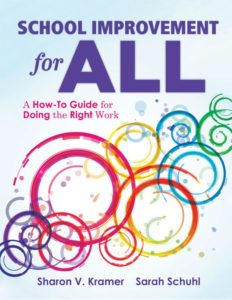A How-To Guide: School Improvement for All
School Improvement for All: A How-To Guide for Doing the Right Work
By Sharon V. Kramer and Sarah Schuhl
(Solution Tree Press, 2017 – Learn more)

I wonder if you, like me, are always a bit wary of any claim that uses an absolute. Examples are “Get ALL of your clothes clean and bright” or “Eat ALL these foods to stay healthy” or “Use ALL these interview tips to get your dream job.”
Such statements usually make me feel that the authors are a bit shady, as I mentally scoff that nothing can live up to the ALL claim.

In the interests of full disclosure, I must also reveal that I was already a huge fan of professional learning communities (PLCs). Along with some negative experiences where the concept was horribly misapplied, I have more often seen the power of PLCs with their beautiful “Aha!” moments for teachers, and the resulting increases in student learning.
What makes PLCs effective
This book describes PLCs for school improvement and provides just the right mix of theory and application, with lots of useful charts and templates that are easily customized for the work in any educational setting.
Every chapter starts with commentary about how to determine vision versus reality, outlines ways to get from one to the other, and then provides concrete tools and steps to follow as a plan of action. The subtitle “A How-To Guide for Doing the Right Work” is also accurate.
In fact, I bet that just quickly flipping through the pages will show you a chart or table that is relevant to work on a team. The book is also a quick read – not something that is so metaphorically heavy it just sits on the shelf in the “Yeah, I should read that sometime” pile. When your book arrives, please move it into the “I can use this now” pile.
How the book starts
The introduction has a “Duh!” feel as the authors note that leadership requires assembling a team both willing and capable of leading change. Also, once designed, the activities “demand a commitment from everyone to be all in for student success” (p. 3).
In the first chapter the authors point out that “The single most important task a principal can do to ensure high levels of learning for students and adults is to build a leadership team. We use the term school learning team and within that structure, the principal is not an ‘instructional leader’ but the ‘lead learner’ on the team” (p. 9).
Those labels appealed to me because very often coaching, mentoring, or other support programs operate from the perspective of “I know it and you don’t, so let me help you” – instead of from the ground level with a “let’s study this and learn together” perspective.
From “working hard” to “working right”
The book goes on to explain that “Once teams understand the current reality, the next step is to create a shared vision for change” (p. 16). One of the key themes of the book is that “Collaborative teams must engage in the right work.” Most educators can tell horror stories of meetings that stretched on without purpose or accomplishment, in spite of the best intentions and lots of intense work. That idea of switching expectations from simply “working hard” to doing the “right work” really resonated with me.
The chapter on transforming both the culture and the structures or processes within a school provides both the philosophy — “To move from a toxic or negative culture to a healthy culture requires a shift in mindset for the staff” (p. 29) — and some practical ideas and charts, such as taking an artifact walk around the school while reflecting on and recording important symbols and rituals.
The suggested activities build on the idea of moving from the current reality to the vision. Before any movement can happen, the starting point must be established.
Updating tools to reach all students
The next chapter reminds us that we must first operate with the belief that all students can learn and extends that idea to our obligation to understand and provide the 21st Century Skills students need now and in the future. To do this, “As teachers work to improve learning, it is critical to know who 21st century learners are and what they need to be successful” (p. 42).
Among the ideas discussed are the need for students to learn process skills and standards in each subject area, and to experience more student-centered learning. It is only when our education system makes some of those shifts that we will truly be able to prepare students for the world they will inhabit.
Shared understandings of standards and curriculum
Chapters 4 and 5 discuss the idea of a “Common Guaranteed and Viable Curriculum” and the corresponding use of Common Assessments, both of which come under that umbrella of the “right work.” The emphasis is not necessarily on having the same curriculum for all, or even the same standards for all, but instead on the idea that within the team, or school, or district, or whatever the group is, all the members must share the same understanding of the standards and curriculum. “With a guaranteed and viable curriculum, teams can work intentionally and focus their efforts on clearly defined student outcomes” (p. 57). This is because:
Five different teachers can read a standard and interpret it five different ways. To have a guaranteed and viable curriculum that is equitable for all students, teachers on a collaborative team must share an understanding as to the content and skills students must demonstrate to be proficient with the standard.” (p. 63)
Once that understanding is in place – and the book provides some tools to help teams find that place – then they can determine the best common assessments to use. “It is not that one type of test is good and another bad; rather, the lack of balanced assessment vision in a school often leads to over-testing and under-instructing” p. 79).
Again, the focus is not on the inherent qualities of a particular assessment but instead on how the assessment in question fits into the shared understandings that the team has developed.
Designing meaningful instruction
The next step in the school improvement process, outlined in Chapter 6, is that of meaningful planning and effective instruction. Most of us would agree that “Designing meaningful and effective instruction is one of the most critical tasks that teaching requires – and one that greatly influences student learning” (p. 113).
But I also know the reality that planning is often treated as a step-child, and planning time is rescinded or filled up with other activities deemed more critical or immediate. In other instances “common planning” is simply mandated without adequate supports, so that time is wasted and teachers become resentful.
Once the school improvement team has established their instructional vision, they can then begin to plan and determine effective instructional strategies. The authors provide some tools for analyzing current practice and then moving toward implementing effective strategies. They also list nine strategies that research by Marzano and others has shown to be effective, and reiterate the need to match them to student learning needs.
Intertwined accountability
The last chapter, “Embracing Accountability,” includes the dreaded “A” word, but uses the term in a much more realistic manner than is often used in the public narrative of education.
In the same way that collaborative learning in the classroom requires both individual and group accountability, in the school improvement work suggested in this book teacher teams, school leadership, and impacted students all have responsibilities to the process that make them all accountable to each other and to the whole.
The authors ask this question: “Why do teachers do the difficult, time-consuming, and at times spirit-draining work of designing lessons, creating and administering assessments, responding to students’ learning, and taking time to really know students?” They respond with: “This entire book rests on the premise that the answer is this: because of a desire for all students to learn at high levels and to open the doors of opportunity to every student.” (p. 137).
This is a practical book. The term “lead learner” is applied to the administrator on the School Improvement Team described by the authors. If you are such a “lead learner” or any other educator who is a “learner,” you will find this book a useful addition to your bookshelf. A Study Guide and additional resources are also found on the publisher’s website here, accessible through registration.
Kathy Pham is a National Board Certified Teacher with 37 years of experience in Miami-Dade County Public schools, where she has taught Language Arts and worked in the Professional Development Department. As a member of NBCTs of Miami-Dade, she has collaborated with the district and the union to provide opportunities for NBCTs to contribute to the profession and support early career teachers.
She recently completed a Doctoral Program at Florida State University where she studied the experiences and perceptions of teachers who participated in the iHEAT Program of her district.


































